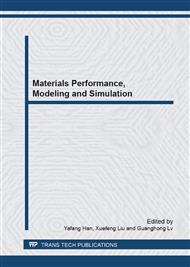p.328
p.337
p.343
p.349
p.356
p.361
p.366
p.372
p.378
Effect of Technological Parameters on Preparation of Mg-Based Foam Materials
Abstract:
As a novel material, Mg-based foam material not only has fantastic physical characteristics, such as low density, high specific surface area, high specific strength and stiffness, and good biocompatibility, but also has special functional properties, for example, electromagnetic wave shielding, vibration reduction, sound absorption, and so on. It can be widely applied to aeronautical and aerospace, military, shipbuilding, transportation, automotive and medical industries. Mg-based foam material was prepared by direct foaming in magnesium alloy liquid in this study, and the effect of technological parameters on the products, such as addition amount of and granularity of SiC particles and MgCO3 particles, stirring temperature, stirring time, stirring velocity, foaming temperature and foaming time, was investigated. The aim of this research was to develop a new technology which could fabricate large scale Mg-based foam material in air condition. The results showed that variations of technological parameters may affect preparation of the foam materials in some extent and resulted in the changes of the products in apparent density, porosity and structural uniformity. The light weight Mg-based foam with homogeneous pores could be obtained by suitable combination of the technological parameters.
Info:
Periodical:
Pages:
356-360
Citation:
Online since:
March 2013
Authors:
Price:
Сopyright:
© 2013 Trans Tech Publications Ltd. All Rights Reserved
Share:
Citation:


